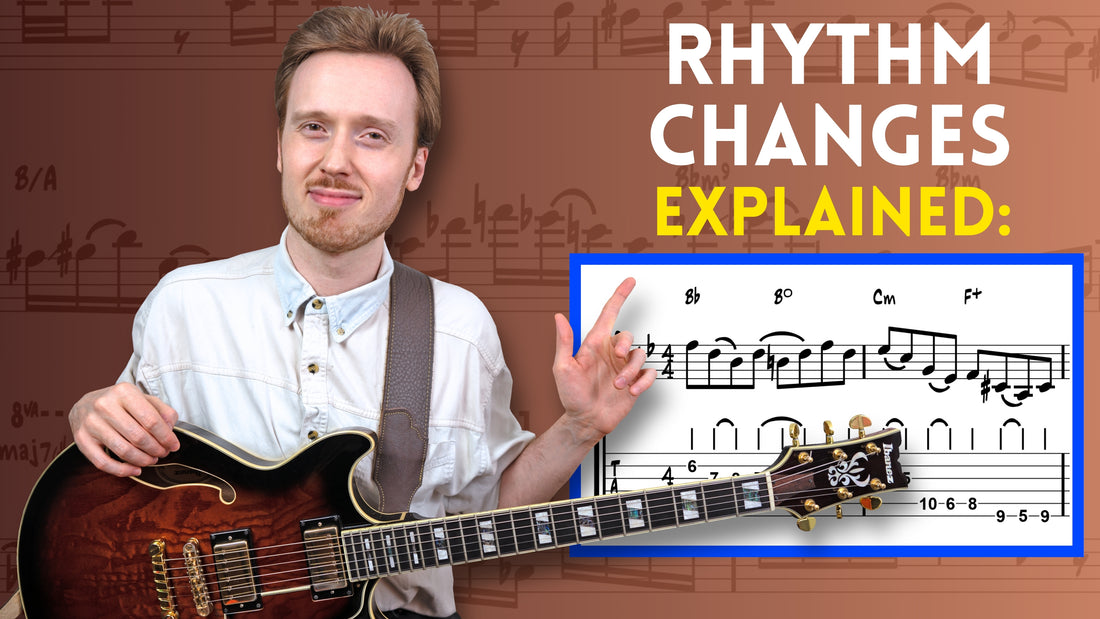I first became aware of Rhythm Changes while trying to navigate chord progressions as an aspiring improviser during my teenage years. The inherent logic of the repeating I-VI-ii-V and iii-VI-ii-V progressions, methodically organized within a 32-bar AABA form, was both enticing and enthralling to my developing musical mind.
Additionally, after discovering numerous recorded examples of my guitar heroes effortlessly maneuvering improvised lines through their own compositions based on the classic Rhythm Changes progression—Pat Metheny’s 'Rejoicing,' John Scofield’s 'Grace Under Pressure,' and George Benson’s classic recording of Jimmy Smith’s 'Ready and Able,' among many others—I felt compelled to find my own way to approach this well-traveled set of chord changes.
The Rhythm Changes progression is historically derived from the chord progression underpinning George Gershwin’s 'I Got Rhythm.' Despite this historical origin, Rhythm Changes have arguably taken on a life of their own, particularly due to contrafacts composed from the bebop era onward by artists like Charlie Parker ('Dexterity,' 'Chasin’ the Bird'), Thelonious Monk ('52nd Street Theme,' 'Rhythm-A-Ning'), Sonny Rollins ('Oleo,' 'The Bridge'), and Miles Davis ('The Theme'), among others.
A cursory glance at the classic Rhythm Changes progression reveals a series of Major 7, Minor 7, and Dominant 7 chords (with the possible addition of a Diminished 7 chord, depending on which Rhythm Changes progression you’re referring to). However, when first learning to solo over these changes, I find it useful to limit yourself to voice leading and soloing with arguably the most elemental of all theoretical materials: Triads.
In my recent Rhythm Changes PDF lesson (which includes standard notation and tab), you’ll find two triad-based exercises centered around a typical 32-bar instance of the Rhythm Changes progression. I also demonstrate these exercises in my full Rhythm Changes lesson video on YouTube.
Since we're aiming for an exercise in limitation to ensure the most efficient voice leading, Exercise 1 will feature an A section built entirely from Major and Minor triads (with the exception of one unavoidable Diminished triad). In the typical Rhythm Changes key of Bb, the A section would appear as follows, spanning a total of 8 bars:
Exercise 1, A section example
These chord changes are essentially repeated in the following two A sections within the 32-bar form. The B section typically features a series of Secondary Dominant chords, also spanning 8 bars. In Bb Major, this would include D7 (III⁷), G7 (VI⁷), C7 (II⁷), and finally F7 (V⁷). Once again, in keeping with our limitation of using only triads for efficient voice leading, here is the B section with only Major triads:

Exercise 1, B section example
To incorporate all four triadic qualities—Major, Minor, Diminished, and Augmented—Exercise 2 employs a more creative array of triads in the A section. Notably, the chords F7 and G7 are framed by the harmony of Augmented triads (F+ and G+) in bars 2, 3, 4, 7, and 8:

Exercise 2, A section example
Once again, these chord changes are essentially repeated in the following two A sections (with slight variations). In this instance of the B section, rather than using Major triads as we did in Exercise 1, we will utilize Augmented triads to create a more open sound in place of the Secondary Dominant chords typically found in the B section:

Exercise 2, B section example
Between Exercises 1 and 2, we now have a basic triadic framework through which we can voice lead arpeggios across the entire form of a Rhythm Changes progression. This framework provides the foundation for incorporating a wide variety of Major 7, Minor 7, Dominant 7, and Diminished 7 arpeggios (among others) throughout the form.
Additionally, it is very common for improvising soloists to rely on basic Blues Scale-derived ideas when soloing over the A sections of the Rhythm Changes. While this is certainly a viable improvisational approach (if only momentarily), it can very swiftly enter the land of cliché—especially if the soloist is using the Blues Scale to compensate for an underdeveloped command of improvisational language. A more beneficial approach is to build a strong foundation rooted in the knowledge of arpeggios and voice leading, with a particular focus on triads.
Let me know if this primarily triadic approach has been beneficial to your improvisational development, and if there are any additional methods that have helped you along the way. If you’d like to explore these approaches in more depth, check out my recent Rhythm Changes PDF lesson (with standard notation and tab). For more on soloing exclusively with triads, check out 'How To Solo With Triads' at Ben’s Guitar Club.
Keep on shredding,
Ben.


1 comment
Incredibly helpful and insightful, Ben. Thank you as always.